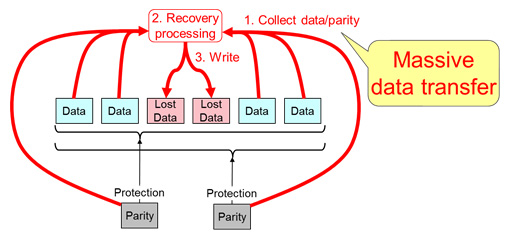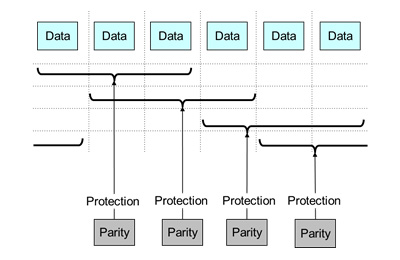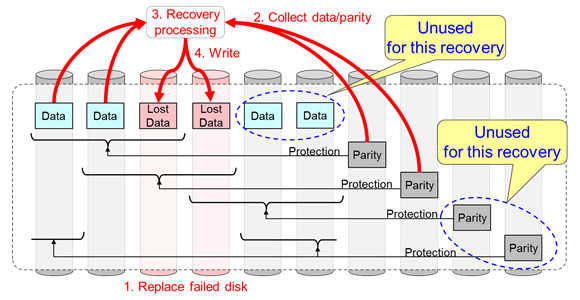Fujitsu Labs Develops Faster Recovery Process for Multiple HDD Failures
Allows for same degree of protectionof RAID as triple-redundancy with less actual redundancy.
This is a Press Release edited by StorageNewsletter.com on October 17, 2014 at 2:54 pmFujitsu Laboratories Ltd. announced the development of a disk recovery technique that is faster than existing methods and that can handle multiple failures, reducing the risk that important data will be lost.
RAID is a widely used technology for protecting data against disk failures, but with the explosive growth in data being generated through the use of web services, the increase in time needed to recover data lost through disk failures is becoming a problem.
Fujitsu Labs has developed a high-speed recovery process, devising a structure for managing block of data – units of storage – by group, which maintains the same tolerance to disk failures as the existing RAID technology while speeding up recoveries by 20% or more with flexible trade-off of space efficiency in accordance with the usage scenario when there are multiple failures, such as when two disks fail simultaneously.
The development of this process will enable faster recovery of storage as online content increases in line with an expansion in cloud and web services.
Background
In recent years, digital media data, which plays a central role in web services, has been experiencing a rate of growth, exceeding 70% per year. The importance of data to these services means that a number of measures are used to guard against digital media data loss, including triple-redundant copies, but the sheer volume of data means that the cost of storage cannot be ignored. Triple-redundant storage means triple the storage requirements; to use storage capacity more efficiently, in recent years RAID technology, long established as a method of protecting companies’ mission-critical data, has been receiving renewed attention. Rather than storing complete copies of each piece of data, introducing ‘parity’ – redundant pieces of data that summarize other data as part of a protection system – allows for the same degree of protection as triple-redundancy but with less actual redundancy.
Figure 1: Switching from triple redundancy to RAID improves capacity utilization
Issues
In standard RAID implementations, such as the widely used RAID-5 and RAID-6, all the parity is used to protect all the data. If a given disk fails, it is necessary that together with the parity that protects each piece of data stored on the failed disk, the remaining data be used to reconstruct the lost data. This means a lengthy recovery process and an increased risk that additional data will be lost during the recovery process itself. For example, when using 48 disks, each with 4TB capacity and 15Mb/s random I/O performance, recovering from simultaneous failures of two disks is calculated to take more than 10 hours.
Figure 2: In conventional RAIDs, data recovery involves massive data transfers
About the Newly Developed Technology
Fujitsu Laboratories has developed a method to quickly recover data while maintaining the same levels of reliability as RAID technology.
Features of the new technology are as follows:
Multilayered parity-protection reduces data recovery processing volume
The range of protection offered by each parity does not cover all of the data, but rather is limited to a portion of the data. Additionally, Fujitsu Laboratories developed an approach using a partially overlapping range of parity protection (Figure 3) to protect any of the pieces of data from loss. When a disk fails, only the minimum combination of parity and data needed for recovery is used, which shortens recovery time.
Figure 3: Range of multilayered parity protection
Data and parity are distributed over the different disks that make up a storage system. When a disk fails, recovery is performed by selecting the parity with the minimum amount of processing to recover the lost data that had been stored on that disk (Figure 4).
Figure 4: Accelerated recovery of lost data when disk fails
For example, in a comparative test for recovery of up to two simultaneously failed disks using the above mentioned 48 disks, each with a 4TB capacity, when the protected range of parity is configured as described in Figure 4, the results confirmed that it was possible to shorten recovery time by over 20% compared to current RAID technology.
Structure for parity protection range can flexibly change with usage contexts
With the multilayered, overlapping structure of parity-protection range, there are mutual tradeoffs between recovery time (dependent on the minimum data-processing volume needed to restore data), probability of data loss (dependent on the number of parities that protect each piece of data), and capacity utilization efficiency (dependent on the ratio between data and parity). The range of parity protection can be tuned to provide the best balance given the importance of the data being stored.
Results
The use of this technology accelerates the recovery of data when a disk fails, even in the face of the growth in stored data volume. This can be used to speed up recovery from storage devices with burgeoning content from cloud services and web services.
Future Plans
Fujitsu Laboratories plans to continue making improvements to this content-recovery technology with the goal of a practical implementation during fiscal 2015.

















 Subscribe to our free daily newsletter
Subscribe to our free daily newsletter

